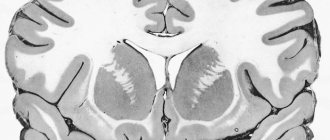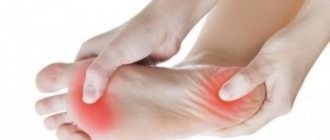Histology.RU
Material taken from the site www.hystology.ru
The terminal apparatus of nerve fibers - nerve endings - differ in their functional significance. There are three types of nerve endings: effector, receptor and terminal devices as part of interneuronal synapses.
Effector nerve endings - these include motor nerve endings of striated and smooth muscles and secretory endings of glandular organs.
The motor nerve endings of striated skeletal muscles - motor plaques - are a complex of interconnected structures of nervous and muscle tissue. The motor plaque is the effector apparatus of the axons of the nerve cells of the motor nuclei of the anterior horns of the spinal cord or the motor nuclei of the brain and muscle fibers. Morphologically, it consists of a nerve pole - the terminal part of the neuron axon and a muscle pole, a specialized section of muscle fiber - the base of the motor plaque (Fig. 166).
The motor nerve fiber near the muscle fiber loses the nuclei of glial cells and myelin sheath accompanying the axial cylinder. The axial cylinder, breaking up into several terminal branches, is immersed in a specialized spine of muscle fiber.
The sacrolemma in the area of the nerve ending forms numerous submicroscopic folds that form secondary synaptic clefts of the motor terminal.
The muscle fiber in the area of the base of the motor plaque does not have myofibrils and transverse
Rice. 166. Motor nerve ending (motor plaque):
A — profile view (a and b — endings of the myelin nerve fiber, c — myelin fiber, d — muscle fiber, e — muscle fiber core); B — top view (a — myelinated fiber, b — unmyelinated nerve fiber, c — fiber emerging from a motor plaque and ending in another motor plaque, the so-called “ultraterminal fiber”).
Rice. 167. Scheme of the structure of a motor plaque:
1 — lemmocyte cytoplasm; 2 - core; 3 - neurilemma; 4 - axial cylinder; 5 - sarcolemma; 6 — terminal branches of the nerve fiber in longitudinal and cross sections; 7 - mitochondria in neuroplasm (axoplasm); 8 - primary synaptic space; 9 - sarcosomes; 10 - secondary synaptic space; 11 - synaptic vesicles; 12 - presynaptic membrane; 13 - postsynaptic membrane; 14 - core of the motor plaque (muscular); 15 - myofibril, consisting of myoprotofibrils.
striations. Here the cytoplasm contains a significant number of mitochondria and round or oval nuclei. The combination of these muscle fiber structures in the area of the nerve ending forms its muscle pole.
The terminal branches of the axial cylinder of the nerve fiber are characterized by the presence of mitochondria and numerous synaptic vesicles containing the mediator acetylcholine (Fig. 167). The latter, when depolarizing the axon plasmalemma - the presynaptic membrane - enters the synaptic cleft and the cholinergic receptors of the postsynaptic membrane, which is the sheath of the muscle fiber, which causes excitation (a wave of depolarization of the postsynaptic membrane).
Motor nerve endings of smooth muscle tissue are formed by nerve fibers that spread between muscle cells and form distinct extensions containing cholinergic or adrenergic vesicles.
Sensitive nerve endings (receptors) are specialized terminal formations of the dendrites of sensory neurons. In accordance with their localization and specificity of participation in the nervous regulation of the body’s vital functions, two large groups of receptors are distinguished: exteroceptors and pteroceptors. Depending on the nature of the perceived irritation, sensitive endings are divided into mechanoreceptors, chemoreceptors, thermoreceptors, etc.
Rice. 168. Lamellar corpuscle (Vater-Pacini corpuscle):
1 - outer flask; 2 - inner flask; 3 - terminal section of the nerve fiber (according to Clara).
Rice. 169. Tactile (Meisierian) corpuscle:
1 - capsule; 2 - special cells.
Sensitive nerve endings are very diverse in their structural organization. They are divided into free nerve endings, consisting only of the terminal branches of the dendrite of the sensitive cell, and non-free ones, containing glial cells. Non-free endings covered with a connective tissue capsule are called encapsulated. An example of free nerve endings is the terminal branching of the dendrites of sensory cells in the epidermis of the skin, where sensory nerve fibers, penetrating into the epithelial tissue, break up into thin terminal branches.
The sensory endings in the connective tissue of animals are very diverse, which are represented by two groups: non-encapsulated and encapsulated nervous apparatus. The former contain a branching axial cylinder of fiber accompanying glia. The latter are characterized by the presence of a connective tissue capsule and the specificity of the morphology and functions of their glial elements. The group of such sensitive endings includes lamellar corpuscles (Vater-Pacini corpuscles), tactile corpuscles (Meissner corpuscles), genital corpuscles, etc. (Fig. 168, 169).
Rice. 170. Scheme of the structure of a lamellar body:
1 - layered capsule; 2 - inner flask; 3 - dendrite of a sensitive nerve cell; 4 - spiral collagen fibers; 5 - fibrocytes; 6 - glial cells with cilia; 7 - synaptic contacts of the axons of secondary sensory cells with the dendrites of the sensitive nerve cell (according to Othelin).
The lamellar body consists of an internal flask and a capsule. The inner flask is formed by specialized lemmocytes. The axial cylinder, the terminal section of the sensitive nerve fiber, is immersed in it. Penetrating into the inner flask, it breaks up into the finest terminal branches.
The capsule of the lamellar body consists of a large number of connective tissue plates formed by fibroblasts and spirally oriented bundles of collagen fibers. At the border of the outer capsule and the inner flask there are cells that are presumably defined as glial. They form synapses with the branches of the axial cylinder (Fig. 170). It is assumed that the nerve impulse is generated under conditions of displacement of the outer capsule in relation to the inner bulb. Lamellar bodies are characteristic of the deep layers of the skin and internal organs.
Tactile corpuscles are also formed by glial cells, which are oriented perpendicular to the long axis of the corpuscle, and spread along their surface with terminal branches of the axon. The surface of the body is covered with a thin connective tissue capsule.
The genital corpuscles of the genital organs are constructed similarly. A distinctive feature of this type of ending is that not one axial cylinder penetrates into the genital body under the capsule, but several. The latter branch between the glial cells of the body. Krause flasks are built according to the same scheme, the function of which is associated with temperature sensitivity. When they are excited, the transmitter enters the synaptic cleft on the cholinergic receptors of the postsynaptic membrane of the muscle fiber and causes an impulse (depolarization wave).
Skeletal muscle receptors - muscle spindles contain several intrafusal muscle fibers covered by a common connective tissue capsule. The spindle usually consists of two thick central muscle fibers and
Rice. 171. Scheme of the structure of the neuromuscular spindle:
A - motor innervation of intrafusal and extrafusal muscle fibers (according to Studitsky); B - spiral afferent nerve endings around the intrafusal muscle fibers in the area of the nuclear bursae (according to Kristich with modification); 1 - motor plaques of extrafusal muscle fibers; 2 - motor plaques of intrafusal muscle fibers; 3 - nuclear bag; 4 - nuclear bag; 5 - sensitive annulospiral nerve endings around the nuclear bursae; 6 - striated muscle fibers; 7 - nerve.
four thin ones (Fig. 171). The equatorial part of the thick fibers is filled with clusters of nuclei - the “nuclear bag”. In thin muscle fibers, the nuclei are arranged in a chain, forming a nuclear chain. Sensitive nerve fibers are presented here in two types. Some form spiral curls surrounding the equatorial, nuclei-containing part of the thick intrafusal muscle fibers - “annular endings”. The endings of the second group of sensory fibers are represented by both annular endings and secondary grape-shaped endings, one on each side of the primary. The endings of the first group react to the degree of muscle stretching and its speed, the secondary ones - only to the degree of stretching. The endings of motor nerve fibers are localized at both poles of the muscle fibers and have a structure typical of a motor plaque.
An interneuronal synapse is a specialized contact between two neurons that provides one-sided conduction of nerve excitation. Morphologically, the synapse is divided into a presynaptic pole, the terminal section of the first neuron, and a postsynaptic pole, the area of contact of the second neuron with the presynaptic pole of the first. There are synapses with chemical and electrical transmission.
At the point of contact of the preganglionic nerve fiber with the second neuron, there are axosomatic synapses (the axon of the first neuron contacts the perikaryon of the second), axodendritic (the axon of the first neuron interacts with the dendrite of the second) and axoaxonal (the axon of one neuron ends on the axon of another) (Fig. 172). It is assumed that the latter does not excite a nerve impulse on the second neuron, but inhibits the excitation received by the neuron through other synapses.
Morphologically, the presynaptic pole of the synapse is characterized by the presence of synaptic vesicles containing a transmitter (acetylcholine or norepinephrine), mitochondria, single cisterns, and sometimes neurotubules. Participation in the transmission of a nerve impulse to the next neuron is determined by the natural release of a transmitter into the synaptic cleft by exocytosis.
Rice. 172. Diagram of the ultramicroscopic structure of various types of synapses:
A - cytotopography of synapses; B - inhibitory synapse; B - excitatory type synapse; G - electrotonic synapse; 1 - axosomatic synapse; 2 - axodendritic synapses; 3 - axoaxonal synapse; 4 - dendrites; 5 - dendritic spine; 6 - axon; 7 - synaptic vesicles; 8 - presynaptic membrane; 9 - postsynaptic membrane; 10 - synaptic cleft; 11 - postsynaptic structures.
The latter, entering the membrane of the postsynaptic pole, causes a change in its permeability, a wave of depolarization - the generation of a nerve impulse. In addition to those mentioned above, other substances can also play the role of a mediator, namely: adrenaline, serotonin, gamma-aminobutyric acid, etc.
Synaptic vesicles carrying various mediators are morphologically different. In cholinergic synapses they are: small (30 - 40 nm) and transparent. They sometimes also contain several very large and electron-dense bubbles (80 - 150 nm), the chemical composition and significance of the latter are currently unclear. Presumably they are believed to contain biogenic amines. Synaptic vesicles of adrenergic synapses are larger (50 - 90 nm) and are morphologically characterized by the presence of an electron-dense granule in them. The mediator is released by exocytosis into the synaptic cleft of the contents of synaptic vesicles.
The postsynaptic membrane of cholinergic synapses contains a “cholinergic” protein. When interacting with acetylcholine, conformational changes in its molecules occur, leading to changes in membrane permeability and the generation of a nerve impulse in a neuron (Fig. 173). The mediator of inhibitory synapses - gamma-aminobutyric acid does not increase the permeability of the postsynaptic membrane for ions, but reduces it and, therefore, stabilizes the membrane potential, that is, it inhibits the generation of a nerve impulse.
There are characteristic specializations on synaptic membranes. Under the membranes of both the presynaptic and postsynaptic poles, accumulations of dense material and thin filaments are noted. Clusters are usually thicker by
Rice. 173. Electron micrograph of an axodendritic synapse in the cranial cervical ganglion of a cat (Kozlov’s preparation):
1 - Synaptic vesicles; 2 - mitochondria; 3 - neurotubules in the cytoplasm of the dendrite; 4 - thickened postsynaptic membrane.
Rice. 174. Simple reflex arc:
1 - sensitive nerve cell; 2 - receptor in the skin; 3 - dendrite of a sensitive cell; 4 - shell; 6 — lemmocyte nucleus; 6 - myelin sheath; 7 - interception of nerve fiber; 8 — axial cylinder; 9 - notch on the nerve fiber; 10 — neurite of a sensitive cell; 11 - motor cell; 12 - dendrite of the motor cell; 13 - neurite of the motor cell; 14 - myelin fibers; 15 — effector (motor plaque); 16 - spinal node; 17 - dorsal branch of the spinal nerve; 18 - posterior root; 19 - posterior horn; 20 — front horn; 21 - anterior root; 22 - ventral branch of the spinal nerve.
presynaptic membrane. Synaptic vesicles are often associated with presynaptic condensations. Tangential sections of the compaction show that they are not homogeneous, but consist of hexagonal and triangular structures, in the center of which a synaptic vesicle can be distinguished. The clusters of vesicles and condensations together are called the synaptic complex, and since they appear to be the sites of predominant accumulation of vesicles and release of transmitter, they are also called active zones. In the area of synapses, small attachment devices are also identified - attachment points (punctum adherens). They differ from the condensations of synaptic complexes in their greater thickness and symmetry and short linear extent.
Electrotonic synapses are formed when the plasma membranes, two neurons, mainly their dendrites, and the perikaryon are closely adjacent.
The nervous system of the body is represented by sensitive, associative and motor cells, united by interneuronal synapses into functionally active formations - reflex arcs. A simple reflex arc consists of two neurons - sensitive and motor (Fig. 174).
The overwhelming majority of reflex arcs of higher vertebrates still contain a significant number of associative neurons located between the sensory and motor neurons.
Reviews (0)
Add a review
Anatomy of intercostal nerves
In the back there are not only the nerve endings of the spine, but also intercostal processes that run along the spaces between the external and internal intercostal muscles. They are initially located under the lower edge of a particular rib, in the area between the vein and artery.
From the upper six nerves, branches extend into the skin of the anterior chest wall, which are called the anterior cutaneous branches. The five lower intercostal nerves and the hypocostal nerve arise from the anterior wall of the peritoneum, extend into the area between the transverse and internal oblique muscles, and pass through the vaginal wall.
The anterior branches (intercostal and subcostal) innervate the external and internal muscle structures, muscles involved in raising the ribs, the transverse thoracic muscle and the abdominal muscle, etc.
From each intercostal nerve, lateral and anterior cutaneous branches arise, which participate in the innervation of the skin of the chest and abdomen. The first are divided into anterior and posterior branches, connect to the medial cutaneous process of the shoulder and are called intercostobrachial nerves.
The anterior cutaneous branches spread from the intercostal nerves, passing along the edge of the sternum and the rectus abdominis muscle. They innervate the mammary glands.
Nerve plexuses of the skin
The skin of the body is innervated by branches of the spinal nerves of the somatic nervous system. In addition to the sensory and motor nerve fibers of the spinal nerves, the skin also contains secretory and sympathetic fibers of the autonomic nervous system.
Nerve trunks entering the skin form plexuses in the hypodermis - the subcutaneous fat layer. From the deep nerve plexus of the hypodermis, many nerve trunks extend into the dermis, forming new plexuses there. These nerve plexuses of the subcutaneous tissue and dermis give off branches to all structural elements of the skin : hair follicles, muscles, blood vessels, sebaceous and sweat glands. Autonomic nerve fibers intertwine blood vessels, regulate their tone, providing tissue nutrition.
Nerve endings of the skin
Sensitive (afferent) nerves are represented in the dermis by free nerve endings or specialized terminal structures - receptors.
Free sensory endings are located in the papillae of the dermis, protruding from below into the epidermis. They perceive the feeling of pain.
Specialized receptors perceive tactile (tactile), temperature, and vibration stimuli. The terminal nerve structures have a complex structure. Differences in structure indicate that each type of nerve ending perceives a separate type of irritation: cold, mechanical, vibration, thermal.
The role of nerve structures of the skin
In 1 sq. cm of skin there are about 300 sensory nerve endings . They are connected by sensory (afferent) nerve fibers to centers in the spinal cord and brain and serve for the skin to perform its function as an organ of touch . The effects of environmental factors are perceived by skin receptors, and the nerve trunks transmit the received signal to the central nervous system. In the central sections of the analyzers, the signals are analyzed and a response is generated. The command is transmitted via motor (efferent) nerve fibers to the periphery for execution - sweating, changes in the lumen of blood vessels, muscle contraction.









